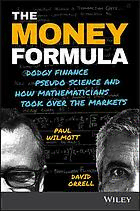
The money formula : dodgy finance, pseudo science, and how mathematicians took over the markets PDF
Preview The money formula : dodgy finance, pseudo science, and how mathematicians took over the markets
The Money Formula The Money Formula DODGY FINANCE, PSEUDO SCIENCE, AND HOW MATHEMATICIANS TOOK OVER THE MARKETS Paul Wilmott David Orrell Thiseditionfirstpublished2017 ©2017PaulWilmottandDavidOrrell Registeredoffice JohnWiley&SonsLtd,TheAtrium,SouthernGate,Chichester,WestSussex,PO198SQ, UnitedKingdom Fordetailsofourglobaleditorialoffices,forcustomerservicesandforinformationabout howtoapplyforpermissiontoreusethecopyrightmaterialinthisbookpleaseseeour websiteatwww.wiley.com. Allrightsreserved.Nopartofthispublicationmaybereproduced,storedinaretrieval system,ortransmitted,inanyformorbyanymeans,electronic,mechanical,photocopying, recordingorotherwise,exceptaspermittedbytheUKCopyright,DesignsandPatentsAct 1988,withoutthepriorpermissionofthepublisher. Wileypublishesinavarietyofprintandelectronicformatsandbyprint-on-demand.Some materialincludedwithstandardprintversionsofthisbookmaynotbeincludedine-booksor inprint-on-demand.IfthisbookreferstomediasuchasaCDorDVDthatisnotincludedin theversionyoupurchased,youmaydownloadthismaterialathttp://booksupport.wiley.com. FormoreinformationaboutWileyproducts,visitwww.wiley.com. Designationsusedbycompaniestodistinguishtheirproductsareoftenclaimedas trademarks.Allbrandnamesandproductnamesusedinthisbookaretradenames,service marks,trademarksorregisteredtrademarksoftheirrespectiveowners.Thepublisherisnot associatedwithanyproductorvendormentionedinthisbook. LimitofLiability/DisclaimerofWarranty:Whilethepublisherandauthorhaveusedtheir besteffortsinpreparingthisbook,theymakenorepresentationsorwarrantieswithrespect totheaccuracyorcompletenessofthecontentsofthisbookandspecificallydisclaimany impliedwarrantiesofmerchantabilityorfitnessforaparticularpurpose.Itissoldonthe understandingthatthepublisherisnotengagedinrenderingprofessionalservicesand neitherthepublishernortheauthorshallbeliablefordamagesarisingherefrom.If professionaladviceorotherexpertassistanceisrequired,theservicesofacompetent professionalshouldbesought. AcataloguerecordforthisbookisavailablefromtheLibraryofCongress. AcataloguerecordforthisbookisavailablefromtheBritishLibrary. ISBN978-1-119-35861-9(paperback)ISBN978-1-119-35866-4(ebk) ISBN978-1-119-35868-8(ebk) ISBN978-1-119-35872-5(ebk) 10 9 8 7 6 5 4 3 2 1 Coverdesignconcept:BeatrizLeon Setin11/13ptNewBaskervilleStdbyAptaraInc.,NewDelhi,India PrintedinGreatBritainbyTJInternationalLtd,Padstow,Cornwall,UK ToOscar,Zachary,Genevieve,andHoratio —PaulWilmott ToWendyandKatherine —DavidOrrell Contents Acknowledgements ix AbouttheAuthors xi Introduction xiii Chapter1 EarlyModels 1 Chapter2 GoingRandom 15 Chapter3 RiskManagement 35 Chapter4 MarketMakers 61 Chapter5 DerivingDerivatives 83 Chapter6 WhatQuantsDo 109 Chapter7 TheRewrite 135 Chapter8 NoLaws,OnlyToys 149 Chapter9 HowtoAbusetheSystem 169 Chapter10 SystemicThreat 189 Epilogue:KeepitSimple 207 Bibliography 227 Index 237 vii Acknowledgements T heauthorswouldliketothankpublisherThomasHyrkiel,project editor Jeremy Chia, production editor Samantha Hartley, and the rest of the Wiley team. Thanks also to Seth Ditchik, Ed Howker, JuliaKingsford,RobertLecker,BeatrizLeon,RobertMatthews,Myles Thompson,andAndreaWilmott. ix About the Authors Paul Wilmott is a mathematician and serial entrepreneur. His text- books and educational programs provide the definitive training for quants; his website wilmott.com is the center of the quant commu- nity;hiseponymousbi-monthly–andaccordingtoEsquiretheworld’s mostexpensive–magazineisaquantmust-have.Asapractitionerhe hasbeenaconsultanttoleadingfinancialinstitutionsandmanaged his own hedge fund. As a commentator he has appeared on many TV and radio programs and written OpEds for the New York Times. Nassim Nicholas Taleb calls him the smartest quant in the world: “He’s the only one who truly understands what’s going on… the onlyquantwhouseshisownheadandhasanysenseofethics.”Paul divideshistimebetweenLondon,theCotswolds,andNewYork. David Orrell is an applied mathematician and writer. Founder of the scientific consultancy Systems Forecasting, his scientific work has encompassed diverse areas such as particle accelerator design, weather prediction, cancer biology, and economics. His books on subjects including prediction, economics, and science have been nationalbestsellersandhavebeentranslatedintoovertenlanguages. A revised and expanded version of his book Economyths: 10 11 Ways That Economics Gets it Wrong is also published this year. He lives in Toronto. xi Introduction “Howaboutthescandalousstoriesofthousandsoffamilieswith smallandmediuminvestmentswhohavebeenruinedbecauseofthe greedoffinancialinstitutionsintheUnitedStatesandEurope. Lookattheevictions,ruinedfamilies,andsuicideattemptscaused bythefinancialcrisisofthosewhohavefailedtocontrolthecapital marketsorthepricesofrawmaterials.¡Vayamierda!”1 —Responsetothesurveyquestion:“Doyouhaveany outrageousorhilariousstoriesthatyouthinkought tobeinPaulandDavid’snewbook?Sharesome details,please!”atwilmott.com “Thetruthabouttheirmotivationinwriting.” —Responsetothesurveyquestion:“Whattopicsshould definitelyfeatureinthebook?”atwilmott.com T heglobalfinancialcrisisthatpeakedinlate2008,andwhoseafter- shockshaveyettofullydissipate, wastheculminationofmanyyears of dubious financial practices. If carried out alone they might have causedonlylocalizedharm,buttheybecamealignedinthewaythat only the most dramatic of astrologers can dream of: a quadrillion dollarsincomplexfinancialproductsthatnooneunderstands;risk- managementtechniquesthathideriskratherthandecreaseit;moral hazard and dangerous incentives; lack of diversification; regulators that are oblivious; mathematicians acting as psychological enablers. Itwasastorywherethena¨ıve,thenegligent,andthedownrightnasty allpulledtogetherinseizingasmuchaspossibleforthemselveswhile almostdestroyingthefinancialfoundationsoftheplanet. 1We’retranslatingfromtheSpanish.Wethinkthat“¡Vayamierda!”isslangfor“Have agreatday!”butwe’renotsure. xiii xiv Introduction Ofcourse,thingshavemovedonsincethen.Thebankingsystem has become even more concentrated. Global debt – the engine fuel of finance – has grown to unprecedented levels. Markets, in which activity is increasingly dominated by high-frequency-trading robots,experienceconstant“flash”eventswherepricessuddenlygo wild before returning to more normal levels. The world financial system is once again rattling at its cage, ready to blow. And quanti- tative finance – the use of mathematical models to assist or dictate investment decisions – has become more powerful and influential thanever. Thestory,inotherwords,isn’tover–notbyalongshot.Indeed, the stakes have never been higher, which is why previously arcane topics such as hedge funds, high-frequency trading, and too-big-to- fail banks have become a major topic of often-confusing debate for everyone from TV pundits to politicians. And why the confusion is oftendeliberate. It has been estimated that in 2010 the notional value of all the financial derivatives in existence was $1.2 quadrillion.2 That’s $1,200,000,000,000,000.Forcomparison,it’sabout17timesthemar- ket capitalization of all the world’s stock markets, or 150 times the value of the above-ground gold supply, or $170,000 for every living humanontheplanet.Actually,it’slargerthantheentireglobalecon- omy. We’ll explain this number, and how it could be interpreted, later. For the moment, let’s just say that whatever it means in terms of risk, it seems like a dangerously big number for what is, let’s be honest,justaserviceindustry. Thisbookisnotaboutthefalloutfromthecrisis–plentyofbooks and column inches have been written about that – but about help- ing to prevent the next one (which won’t look like the last one). To do that, it is necessary to go into the engine room of this massive shadow economy and understand how quantitative analysis works. Howdoyoucreateaquadrilliondollarsoutofnothing,blowitaway, 2ThiswasestimatedbytheeconomistTimHarfordandPaulfortheBBCRadio4 programMoreorLessbasedondatafromthewebsiteoftheBankforInternational Settlements.This“headline”figure,whichisopentointerpretation,includesboth thecontractstradedthroughanexchangeandtheover-the-countermarketinwhich twopartiestradedirectly.Itisalsowhatiscalledthe“notional”value.Ifacontract specifies that it will pay you 1% of $1 million in a year’s time then that would be recordedasanotionalof$1million,whereasit’sreallyjustworthabout$10,000.So it’strickytosaywhatamountreallyisatriskinthat$1.2quadrillion. Introduction xv andleaveaholesolargethatevenyearsofthedeliberatelymisnamed “quantitativeeasing”can’tfillit–andthengobacktodoingthesame thing, only faster? Part of a quant’s job, as we’ll see, is science, and another part (the one where mathematics is used to obfuscate real- ity)istheoppositeofscience.Wewilldiscussboth,startingwiththe science. The book is divided into two main parts. The first five chapters dip into the history of quantitative finance and explain its key prin- ciples, such as risk analysis, bond pricing, portfolio insurance – all those gold-standard techniques, in short, which completely failed duringthecrisis,buthaveyettobeproperlyreinvented.Weexplore the elegant equations used in financial mathematics, and show how the deadly allure of their ice-cold beauty has misled generations of economists and investors. We trace the development of financial derivatives from bonds to credit default swaps, and show how math- ematical formulas helped not just to price them, but also to greatly expandtheirusetothepointwheretheydwarfedtherealeconomy. Andweshowhowrisk-managementandinsuranceschemeshaveled tomoreriskandlessinsurancethanarguablyatanytimeinhistory. Thesecondpartisaboutthequantitativefinanceindustrytoday, and how it is evolving. We will show what quants do, the techniques theyuse,andhowtheycontinuetoputthefinancialsystematperil. Partoftheproblem,we’llsee,isthatquantstreattheeconomyasifit obeysmechanisticNewtonianlaws,and–bynatureandbytraining– have no feel for the chaos, irrationality, and violent disequilibrium to which markets often seem prone. The same can also be said of the regulators watching the system. We’ll lower ourselves into the hiddencavesoffinance,withtheir“darkpools”navigatedbyswarms ofhigh-frequencytraders,andshowhownewideasfromareassuchas complexityscienceandmachinelearningareprovidinganalytictools for visualizing and understanding the turbulent eddies of financial flows.Alongtheway,wewillgrapplewithsomeofthephilosophical andpracticaldifficultiesinmodelingthefinancialsystem–andshow how models are often used less for predicting the future than for tellingastoryaboutthepresent. The authors are both Oxford-trained applied mathematicians, whohaveworkedinavarietyofindustriesbutotherwisecometothis projectfromdifferentangles.Paulisaquintessentialinsider–named “arguably the most influential quant today” by Newsweek – but he is
